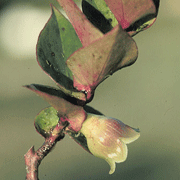James L. Luteyn and Paola Pedraza-Peñalosa
The New York Botanical Garden
|
|
Didonica is a genus of four species of epiphytic shrubs found in premontane habitats in Costa Rica and Panama. Three species are endemic to Panama. The genus is characterized by sympetalous flowers, inferior ovaries, calyces articulate with the pedicels, tubules shorter than the thecae, latrorse dehisce by short, oval clefts which do not extend to the actual tip of the tubule, and berry fruits. The relationships of Didonica should be sought with genera such as Macleania Hook., Psammisia Klotzsch, and Mycerinus A. C. Smith (Luteyn & Wilbur, 1977). Didonica has in common with those genera short (or rarely elongate), broad, somewhat rigid tubules which are also (usually) proportionaly shorter than the thecae. Those genera, however, have strongly, not finely granular thecae, as well as introrse dehiscence which does not suggest a close relationship. |
Another possible relationship is with Vaccinium sect. Oreades Sleumer, which includes several green-flowered species
with bistratose corollas. In that section, V. jefense Luteyn
& Wilbur is unique in that it has latrorse anther dehiscence similar
to but not exactly like that of Didonica. In other staminal
and general floral characters it is quite different from Didonica,
however, and so I do not see any close relationship there either.
Consequently, Didonica continues to represent a rather distinct
evolutionary line and I am still unable to suggest with confidence its
relationships to other genera in the Vaccinieae.
Luteyn and Wilbur (1977) named and described Didonica, after Dido, the Tyrian princess, maintaining the tradition
of naming ericaceous genera for historical or mythological figures.
The genus was thus treated as monotypic in the Flora of Panama (Wilbur
& Luteyn, 1978). Luteyn (1991a) revised the genus in its entirety
and provided a cladistic analysis. The genus as a whole, as well
as each of the four species, must be considered in extreme danger of extinction
for the localities and habitats in which they have been found are all undergoing
severe alteration at the present time.
DIDONICA Luteyn & Wilbur, Brittonia 29: 255, fig. 1. 1977. Type: Didonica pendula Luteyn & Wilbur.
Epiphytic shrubs. Stems glabrous to variously pubescent. Leaves alternate, estipulate, petiolate, coriaceous, flat to involute, acrodromus, the margins entire or remotely crenate. Inflorescence axillary, flowers solitary or racemose; pedicels short to elongate, articulate with the calyx; floral bract and bracteoles usually small and inconspicuous, the margin glandular-fimbriate. Flowers 5-6--merous; hypanthium terete or apparently bluntly angled, the calyx limb usually terete and campanulate, the lobes broad, relatively inconspicuous, erect; corolla thin or succulent, cylindric-campanulate, usually greenish; stamens 10-12, the filaments distinct, narrowing to a connective which extends to the base of the tubules, the anthers finely granular, incurved at the base, the tubules rigid, slightly shorter than the thecae, somewhat spreading, dehiscing by oval, latrorse clefts which do not extend to the actual tip of the tubule; style glabrous, the stigma peltate; ovary inferior. Fruit a berry. Chromosome number unknown.
Key to Neotropical Species Back to Top
1. Leaves imbricate, clasping to amplexicaul, deeply cordate at
base, the
petiole 2-5 mm long; bud scales broadly
ovate, mucronate; inflorescences
of a solitary flower without rachis;
pedicels 1-3 mm long; corollas
succulent, bistratose, drying coriaceous;
Panama.
2. Stems hirsute; leaves amplexicaul,
flat, the margins entire; flowers
6--merous, the
calyx and corolla hirsute or tomentose; bracteoles
inconspicuous,
ca. 1.5 mm long; Chiriquí Prov. (Fortuna Dam area)
............................................................................................ D. crassiflora.
2. Stems glabrous; leaves clasping
but not amplexicaul, flat to
involute, the
margins remotely crenate; flowers 5--merous,
the calyx and
corolla glabrous; bracteoles large, conspicuous,
concealing calyces,
7-8 mm long; Veraguas Prov. (Cerro Arizona)
............................................................................................. D. subsessilis.
1. Leaves well separated, not imbricate, obviously petiolate,
short-attenuate at base, the petiole 5-15
mm long; bud scales
narrowly ovate to linear, long-acuminate;
inflorescences
racemosely 1-5--flowered; pedicels 15-200
mm long; corollas thin,
not bistratose, drying chartaceous;
Costa Rica and Panama.
3. Stems glabrous or puberulent;
leaves (4.5-)6-16 cm long, the
margins remotely
crenate; racemes 1--flowered; pedicels
long-pendent,
150-200 mm long; flowers 5-6--merous; corollas
ca. 22 mm long;
Costa Rica (Limón Prov.), Panama (Coclé Prov.
at El Valle
and Veraguas Prov. NW of Santa Fé) ....................... D. pendula.
3. Stems glabrous; leaves 4-7
cm long, the margins entire;
racemes (2-)3-4(-5)--flowered;
pedicels 15-25 mm long; flowers
5--merous;
corollas 12-16 mm long; Panama (Coclé Prov. in
Coclesito area)
..................................................................... D. panamensis.
This is a modified version of the taxonomic treatment of Didonica by Luteyn (1991a), "A Synopsis of the Genus Didonica (Ericaceae: Vaccinieae) with Two New Species". This on-line synthesis is published with permission of the American Society of Plant Taxonomists.
